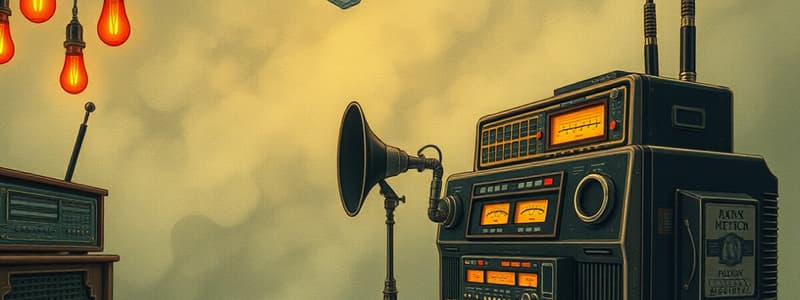Podcast
Questions and Answers
What is the primary benefit of using authorized signals and codes in communication?
What is the primary benefit of using authorized signals and codes in communication?
- It allows for more elaborate explanations during conversations.
- It decreases errors caused by misunderstanding the transmitted message. (correct)
- It eliminates the need for any verbal communication.
- It ensures every message is repeated for clarity.
Which signal should be used to indicate that a member is ending their shift?
Which signal should be used to indicate that a member is ending their shift?
- 10-42 (correct)
- 10-4
- 10-10
- 10-7
What does the Caution Indicator in the Missouri Criminal History Records System signify?
What does the Caution Indicator in the Missouri Criminal History Records System signify?
- It guarantees that the subject has multiple convictions.
- It alerts officers about potential dangerous individuals. (correct)
- It provides a comprehensive criminal history of the individual.
- It indicates the subject has been previously apprehended.
When should an officer use clear, concise language instead of codes?
When should an officer use clear, concise language instead of codes?
Which of the following signals indicates that there is a person present who should not hear the communication?
Which of the following signals indicates that there is a person present who should not hear the communication?
What is the purpose of the 10-23 signal in dispatch communication?
What is the purpose of the 10-23 signal in dispatch communication?
Which signal is associated with determining an individual as a potentially intoxicated driver?
Which signal is associated with determining an individual as a potentially intoxicated driver?
What does the signal 10-8 indicate?
What does the signal 10-8 indicate?
What is the purpose of Caution Indicator One?
What is the purpose of Caution Indicator One?
How does the dispatcher communicate the Caution Indicator to the officer?
How does the dispatcher communicate the Caution Indicator to the officer?
What is recorded on the dispatcher’s radio console when an officer keys the radio?
What is recorded on the dispatcher’s radio console when an officer keys the radio?
Which statement accurately reflects the interaction between the officer's checking and the indicator response?
Which statement accurately reflects the interaction between the officer's checking and the indicator response?
What causes a decrease in radio transmission quality?
What causes a decrease in radio transmission quality?
What does Caution Indicator Two indicate about a subject?
What does Caution Indicator Two indicate about a subject?
What is a key characteristic of I-call conversations?
What is a key characteristic of I-call conversations?
What limitation does the dispatcher have regarding Caution Indicators?
What limitation does the dispatcher have regarding Caution Indicators?
What action will the dispatcher take upon the broadcast of an 'Assist the Officer'?
What action will the dispatcher take upon the broadcast of an 'Assist the Officer'?
What is the primary function of an RF repeater in radio communications?
What is the primary function of an RF repeater in radio communications?
Who is responsible for determining if the situation is under control after a 'Code Five' is dispatched?
Who is responsible for determining if the situation is under control after a 'Code Five' is dispatched?
What must a member in-service do to hold the air when encountering a situation requiring immediate attention?
What must a member in-service do to hold the air when encountering a situation requiring immediate attention?
Which statement accurately describes P25 Conventional communications?
Which statement accurately describes P25 Conventional communications?
The Radio Identification Number (RID) serves what primary purpose in radio communications?
The Radio Identification Number (RID) serves what primary purpose in radio communications?
What constitutes a missed radio call for a member?
What constitutes a missed radio call for a member?
In simplex mode of radio communication, what is a key characteristic of the transmission?
In simplex mode of radio communication, what is a key characteristic of the transmission?
What is the first action a member should take upon realizing they have missed a radio call?
What is the first action a member should take upon realizing they have missed a radio call?
What should the supervisor do upon learning of a missed radio call before the member responds?
What should the supervisor do upon learning of a missed radio call before the member responds?
What is a significant limitation of unencrypted P25 calls?
What is a significant limitation of unencrypted P25 calls?
Which term refers to a collection of channels or talkgroups in radio communication?
Which term refers to a collection of channels or talkgroups in radio communication?
Which form may a member be required to complete after missing a radio call?
Which form may a member be required to complete after missing a radio call?
How does an I-call differ from typical talkgroup communications?
How does an I-call differ from typical talkgroup communications?
What must the responding supervisor inform the dispatcher after determining the situation is under control?
What must the responding supervisor inform the dispatcher after determining the situation is under control?
What feature does a receiving radio have when engaged in P25 communication?
What feature does a receiving radio have when engaged in P25 communication?
What must be prioritized by the Communications Unit before conducting records checks?
What must be prioritized by the Communications Unit before conducting records checks?
What guidance does the use of channels without a D fall under?
What guidance does the use of channels without a D fall under?
Why should requests for records be made using names instead of social security numbers?
Why should requests for records be made using names instead of social security numbers?
What is one of the restrictions on the responses provided by the dispatcher regarding records checks?
What is one of the restrictions on the responses provided by the dispatcher regarding records checks?
What must Department members adhere to when deployed to assist in other jurisdictions?
What must Department members adhere to when deployed to assist in other jurisdictions?
What might happen during peak call times when requesting records checks?
What might happen during peak call times when requesting records checks?
Which of the following is NOT a file that can be searched using a name inquiry?
Which of the following is NOT a file that can be searched using a name inquiry?
Where are repeaters currently located in relation to Kansas City?
Where are repeaters currently located in relation to Kansas City?
Flashcards are hidden until you start studying
Study Notes
Radio Transmission Types
- Individual, Private or I-Call: Direct communication between two radios without a talkgroup; can be intercepted by radio scanners.
- E.P25 Conventional: A digital communication mode; does not use radio systems for transmissions and does not usually communicate with dispatch.
- Radio Identification Number (RID): Unique number assigned to each radio; transmitted during Push to Talk (PTT) to identify the sender and can be displayed on receiving radios.
Communication Systems
- Repeater Function: Enhances communication range by receiving and re-transmitting signals on different frequencies.
- Simplex Mode: Allows radios to communicate directly on the same frequency without a repeater; suited for short-distance communication.
- System or Zone: A grouping of talkgroups/channels to streamline communication and reduce misunderstandings.
Authorized Signals and Codes
- 10-4: Acknowledgment received.
- 10-7: Out-of-service status.
- 10-8: In-service status.
- 10-10: Available while previously engaged with other officers.
- 10-12: Caution, sensitive information may be overheard.
- 10-23: Arrival at scene; critical for dispatcher communication.
- 10-41 & 10-42: Indicate beginning and ending tour of duty, respectively.
- 10-55 to 10-96: Specialized codes for intoxicated drivers, contacting other law enforcement, and emotionally disturbed persons.
Criminal History Indicators
- Caution Indicators: Alerts officers to potentially dangerous individuals; does not confirm a conviction.
- Levels of Caution:
- Indicator One: Physically violent history.
- Indicator Two: Known to be armed.
- Indicator Three: History of assaulting police officers.
Standard Radio Procedure
- Microphone Technique: Maintain a distance of 1-2 inches for clear transmission; clarity and volume are crucial.
- Recording of Conversations: Radio conversations may be recorded, including I-calls.
- Incident Responses: Proper procedures must be taken upon arrival at a scene; radio air may be held by dispatch as required.
Missed Radio Calls Protocol
- A member is considered to have missed a call after three attempts by dispatcher.
- Follow-up: Immediate supervisor must be notified and an explanation provided.
- Documentation: If required, submit an Interdepartment Communication form related to the incident.
Records Checks
- Priority Calls: Highest priority given to emergency calls before conducting records checks.
- Request Process: Use party names instead of Social Security numbers for broader searches across multiple databases.
- Dispatcher Responses: Limited to confirming the presence of warrants; detailed results are not provided over the air.
Studying That Suits You
Use AI to generate personalized quizzes and flashcards to suit your learning preferences.




